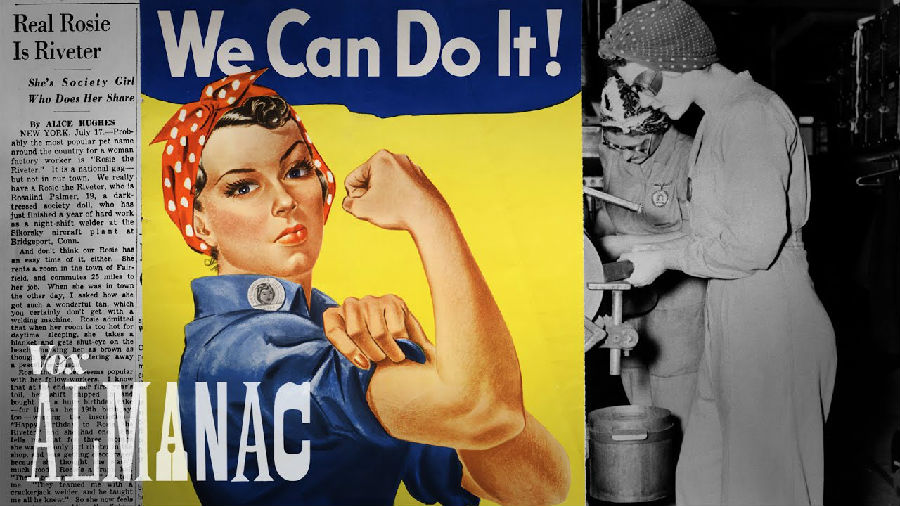Today, this woman's known as Rosie the Riveter.
她就是传说中的“铆工罗西”。
Her poster says "we can do it."
这张海报上写的是“我们能行。”
During World War II, overall American women's employment increased from 12 million in December 1941 to 16 million in March 1944.
二战期间,美国女性就业人数从1941年12月的1200万人增加到了1944年3月的1600万人。
It peaked at 19 million that July.
同年7月,甚至达到了1900万的高峰。
More than 2,000,000 women started jobs in wartime manufacturing specifically — the stuff of riveting.
超200万女性走上了以战争制造业——就是安装铆钉——为典型的各行各业。
They came from other industries, housework, and school.
她们原本不是混迹于其他行业,就是教师或从事家务劳动的家庭主妇。
How did millions of women enter a new industry in the span of a few years?
短短几年之内就有数百万女性涌入一个新的行业,这一切究竟是怎么发生的?
"Here is the office of the supervisor of Women Employees."
“这里是女性员工部门主管的办公室。”
"Women in steel are simply the result of realistic thinking."
“女性进入钢铁行业就是识时务者为俊杰而已。”
"Women of steel" changed labor and helped win a war.
“钢铁女工”不仅改变了美国的劳工格局,也推动了这场战争的胜利。
But how did the country manage to transform a massive war effort on the turn of a dime?
问题是,这个国家是怎么在一时之间彻底完成从战前到战时的切换的?
How did all the women behind this image become riveters?
这幅画代表的所有女性是怎么变成铆钉工的?
"With the army taking men by the thousands,
“由于军队大规模征兵,一征就征走几大千人,
more than 16,000 from our plant so far, we had to find people to replace them.
我们工厂已经被征走16000多人了,没办法,我们就只能找人补上他们的空缺。
A great untapped reserve was women."
一个不错的,尚未被发掘的劳力资源库就是女性。
The Pearl Harbor attack effectively launched the United States into World War II.
(日本)偷袭珍珠港事件直接将美国推上了二战的战场。
The labor pool had to get bigger.
劳力市场必须变大。
Quickly.
时间迫在眉睫。
A group of women in government wanted women to fill in the gaps.
政府部门的一群女性员工希望让女性来填补这一空缺。
In the Department of Labor, Frances Perkins was the first female secretary of labor.
弗朗西斯·珀金斯,劳工部第一位女部长。
She worked with Thelma McKelvey of Women's Labor Supply Services,
与她一起共事的是女工供应部的西尔玛·麦凯尔维,
she was part of the war production board,
麦凯尔维也是战时生产委员会的一员,
which managed the conversion of peacetime industries to meet wartime needs.
负责和平时期各行各业转型,以满足战时所需的就是该委员会。
Mary Anderson was the leader of the Women's Bureau,
玛丽·安德森是女性事务局的负责人,
a Department of Labor agency that advocated for women's employment since 1920.
女性事务局隶属于劳工部,自1920年以来,该局就一直在倡导女性就业。
They all worked with the War Manpower Commission,
她们三人与战时人力委员会达成了合作,

a wartime agency that had a women's advisory committee,
该委员会也是二战时成立的,还设立了女性顾问委员会,
including leaders across industries like efficiency expert Lillian Gilbreth,
顾问都是各行各业的精英,比如效率专家莉莲·吉尔布瑞斯,
lawyer Margaret Hickey, and school principal Maudelle Bousfield.
律师玛格丽特·希基,还有校长莫黛尔·布斯菲尔德。
These groups all helped shape public perception of wartime women workers with ads and PR,
这些团体用广告、公关等方式改变了公众对战时女工的看法,
but the most important process was practical:
但他们最重要的作用却是在实践方面:
they had to help women find the thousands of war industry jobs that needed workers.
她们要帮助成千上万的女性同胞们找到恰好需要人手的军工岗位。
They did that...through the US Employment Service.
她们做到了……在美国就业局的帮助下。
This pamphlet lays out the steps women could take to find a wartime job.
这本小册子列出了女性找战时工作的流程。
The Office of War Information distributed it to magazine editors and the public.
战时信息办公室将小册子分发给杂志编辑或分发到民众手里。
Government work: go to the Civil Service.
找政府工作:就去当公务员。
Military: work in shore stations through a reserve like WAVES.
找军工方面的工作:就通过美国海军女性预备队(WAVES)之类的人力资源库去海岸站。
Industry: find the US Employment Service.
找普通行业的工作:就找美国就业局。
This agency became a subset of the War Manpower Commission.
后来,就业局并到了战时人力委员会下面。
The US Employment Service coordinated local offices,
他们会跟当地办事处协调,
which referred job seekers to employers who could offer war industry work.
办事处就把求职者推荐给提供军工岗位的用人单位。
Employers also recruited through classified ads.
用人单位也可以通过分类广告招聘。
Trade schools advertised to men and women as well.
职业学校男女都招。
As the draft further depleted the supply of male workers,
抽调兵力仍在继续消耗男工,
women filled a host of industrial jobs, from lathe work to welding.
女性便填补了普通行业的大量岗位,从车工到焊接无所不有。
One specific job was perfect for that boom:
有一份特定的工作却显得格外适合这股女工热潮:
As early as May, 1942, Thelma McKelvey said that for aircraft jobs,
早在1942年五月,西尔玛·麦凯尔维就说过,就拿制造飞机来说,
women riveters in particular would be commonplace.
女铆工会变得格外寻常。
"With the ever-increasing demand for greater speeds in aircraft,
“由于人们对飞机速度的需求越来越高,
it has been necessary to remove every possible projection from the outer surface of the airplane."
尽可能取消飞机外壳上的所有凸起就成了必然。”
Industrial jobs clustered around Detroit, Baltimore, and Seattle, with high aircraft and ship production.
工业领域的岗位大多集中在底特律、巴尔的摩和西雅图这些飞机和轮船产量较高的地区。
Increases in women in manufacturing in those cities were huge—especially for...
这些城市的制造业都涌入了大量女性——尤其是……
"Riveters. Learning how and where to put the 700,000 rivets that go into a single Liberator bomber."
“铆工。他们不仅要学习如何把70万个铆钉装到一架解放者轰炸机上,还要知道装在哪儿。”












